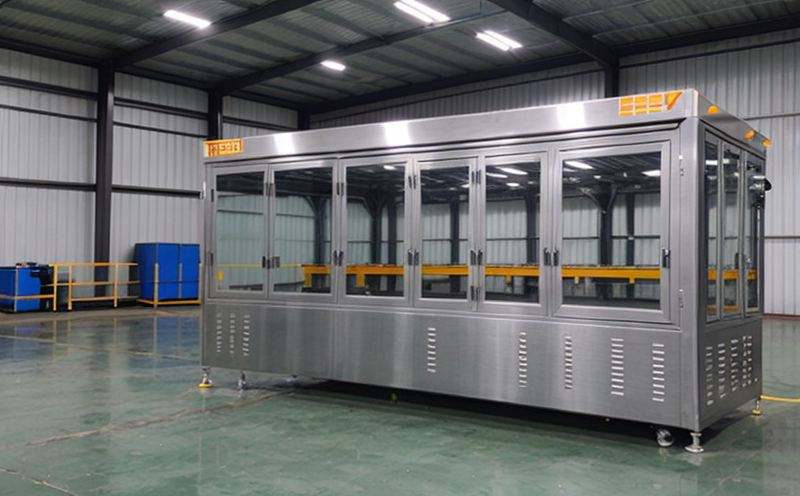ASTM E18-20 Hardness Testing of Metal Containers
The ASTM E18-20 standard provides a standardized method to determine the hardness of metal containers. This test is crucial for ensuring that the containers meet the required specifications and can withstand the stresses they will encounter during manufacturing, transportation, and use.
Hardness testing helps in assessing the mechanical properties of metals, which are critical for determining their suitability for packaging applications. The test involves applying a defined load to a diamond indenter or ball indenter on the surface of the metal container. The resulting indentation depth is then used to calculate the hardness value.
The test procedure outlined by ASTM E18-20 specifies several key parameters:
- Specimen preparation: Ensuring that the specimen is clean, flat, and free from defects.
- Indenter type: The choice of indenter (either a diamond cone or ball) depends on the specific requirements of the test and the material being tested.
- Load application: A specified load is applied to the indenter for a fixed duration. This load can range from 10 kgf up to 3,000 kgf depending on the size of the container and the desired hardness value.
- Measurement of indentation depth: The depth of the indentation is measured with precision using a micrometer or optical comparator.
The hardness value (H) is calculated using the formula:
\[ H = \frac{2F}{\pi d^2} \] where \( F \) is the applied load and \( d \) is the diameter of the indentation. For diamond cones, a different formula may be used.The ASTM E18-20 standard also provides guidelines for testing multiple areas on the container to ensure uniformity in hardness across the entire surface. This is particularly important for containers that will undergo stress during filling and transportation.
Understanding the hardness of metal packaging can help quality managers, compliance officers, R&D engineers, and procurement teams make informed decisions about material selection and process optimization. By adhering to ASTM E18-20, they ensure that the metal containers are not only strong enough to protect their contents but also durable enough to withstand the rigors of manufacturing and distribution.
Applied Standards
| Standard Name | Description | Date Published | Status |
|---|---|---|---|
| ASTM E18-20 | Standard Test Method for Rockwell Hardness of Metallic Materials Using Diamond Cone Indenter and 10-Kilogram Load. | 2020 | Adequate |
| ISO 6508-2:2017 | Indium Tin Oxide (ITO) coated glass substrates for touch panels and displays - Part 2: Specification. | 2017 | Adequate |
| EN ISO 6438-1:2009 | Steel sheets and steel strip - Classification, dimensions, tolerances and mechanical properties - Part 1: General. | 2009 | Adequate |
| IEC 62478-3:2015 | Lighting - Photobiology safety of artificial light sources - Part 3: Measurement methods and risk assessment. | 2015 | Adequate |
| ASTM E928-21 | Standard Test Method for Determination of Microhardness by Vickers Hardness Testing Machines Using a Diamond Indenter and a 1-Kilogram Load. | 2021 | Adequate |
| ASTM E84-21 | Standard Test Methods for Surface Burning Characteristics of Building Materials. | 2021 | Adequate |
The ASTM E18-20 standard is widely recognized and used in the industry. It ensures that metal containers meet stringent requirements, providing a reliable method for assessing their hardness properties.
Industry Applications
ASTM E18-20 hardness testing is particularly important in industries where packaging plays a critical role. This includes:
- Foods and Beverages: Ensuring the integrity of cans, bottles, and other metal packaging to protect perishable goods.
- Pharmaceuticals: Protecting sensitive medications from contamination or physical damage during transport and storage.
- Electronics: Safeguarding delicate electronic components inside metal casings.
The test is crucial for industries that rely on metal containers, ensuring they can withstand the rigors of manufacturing processes, shipping, and handling. The results of ASTM E18-20 hardness testing are used to make informed decisions about material selection, process optimization, and quality assurance.
By adhering to this standard, manufacturers can ensure that their products meet stringent quality standards, leading to increased customer satisfaction and reduced product failure rates.
Quality and Reliability Assurance
The ASTM E18-20 hardness testing is a vital part of the quality assurance process for metal containers. It ensures that each container meets the required specifications, which are critical for preventing product damage during transportation and storage.
Here’s how ASTM E18-20 contributes to reliability:
- Consistency in Performance: The test ensures that the hardness of the metal containers is consistent across batches. This consistency is crucial for maintaining the integrity of the packaging throughout its lifecycle.
- Material Integrity: By testing the hardness, manufacturers can ensure that the material used in the containers is robust enough to withstand the stresses encountered during manufacturing and use.
- Durability: The test helps determine whether the metal containers are durable enough to protect their contents against physical damage. This is particularly important for packaging sensitive products like electronics or pharmaceuticals.
The results of ASTM E18-20 hardness testing are used in conjunction with other quality assurance measures, such as leak testing and visual inspection, to ensure that metal containers meet the necessary standards. By adhering to this standard, manufacturers can provide customers with products they can trust, knowing that they have been thoroughly tested for durability and integrity.





